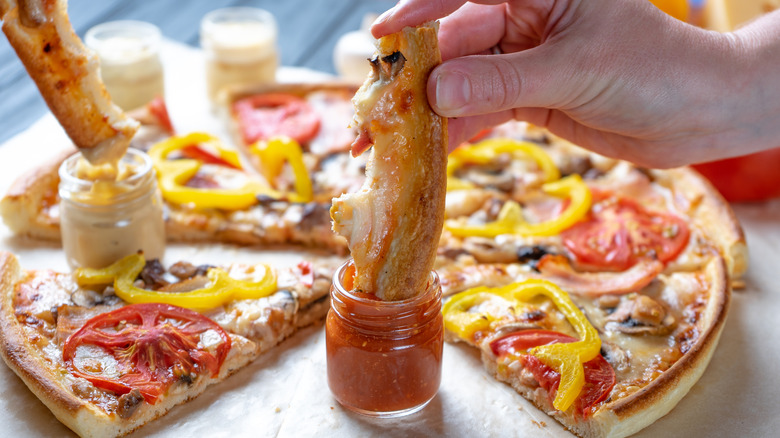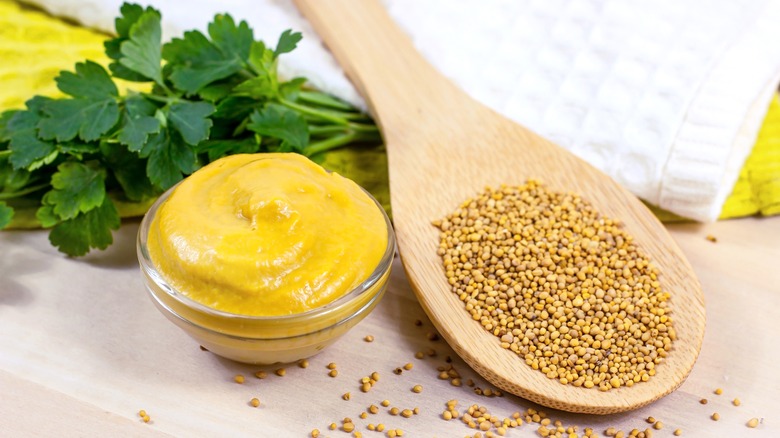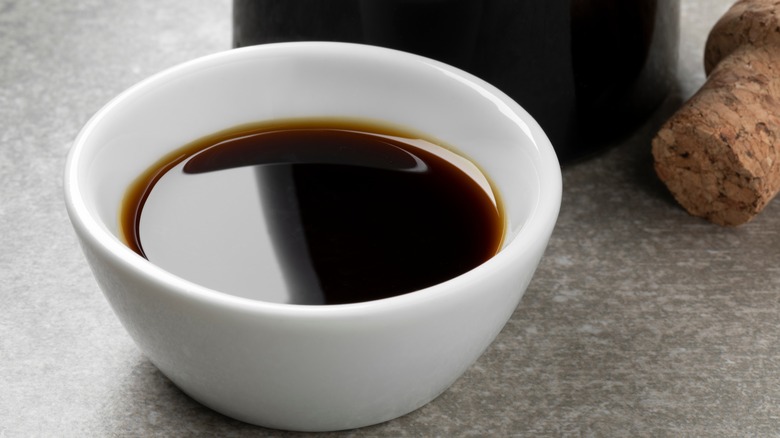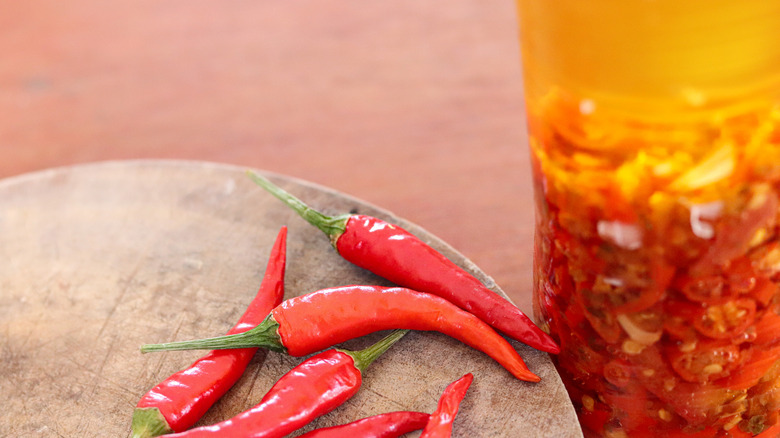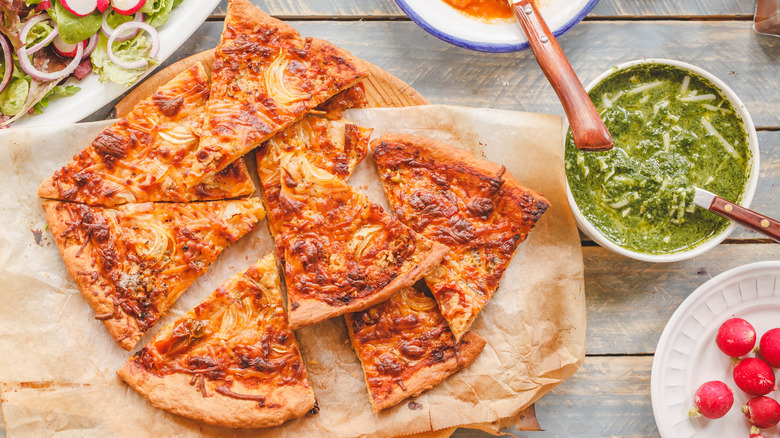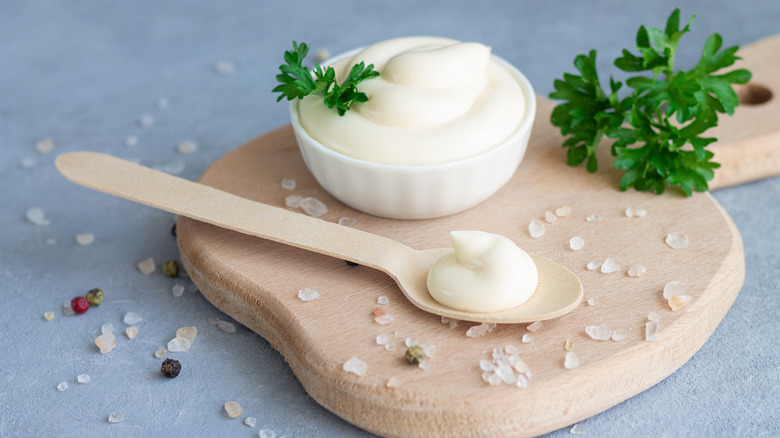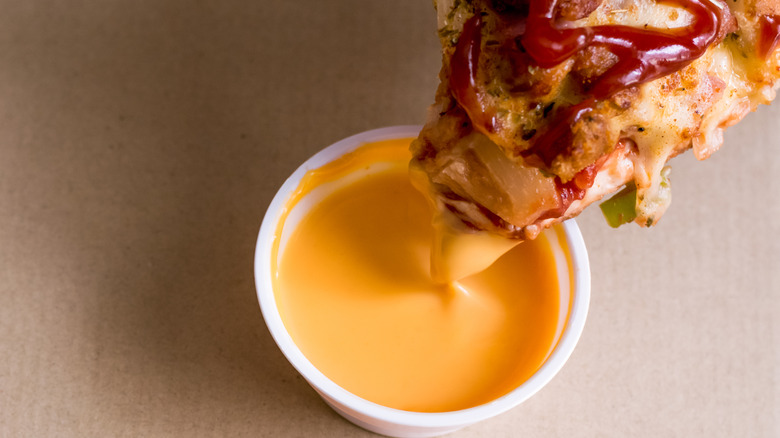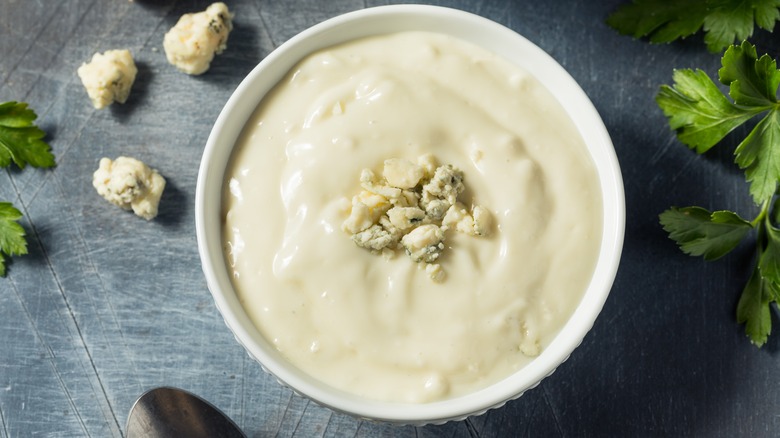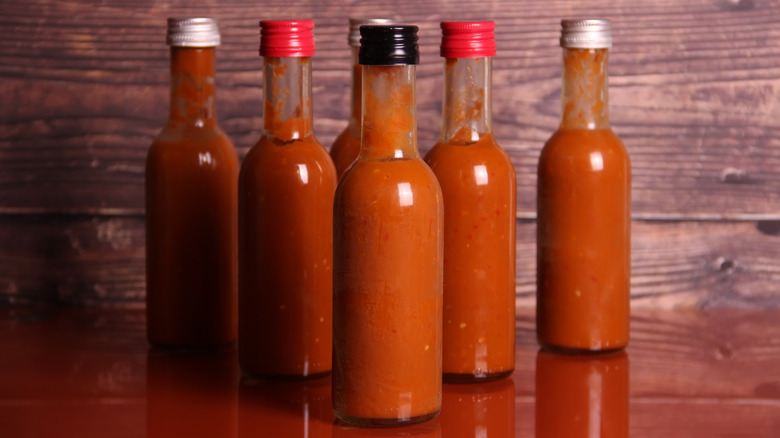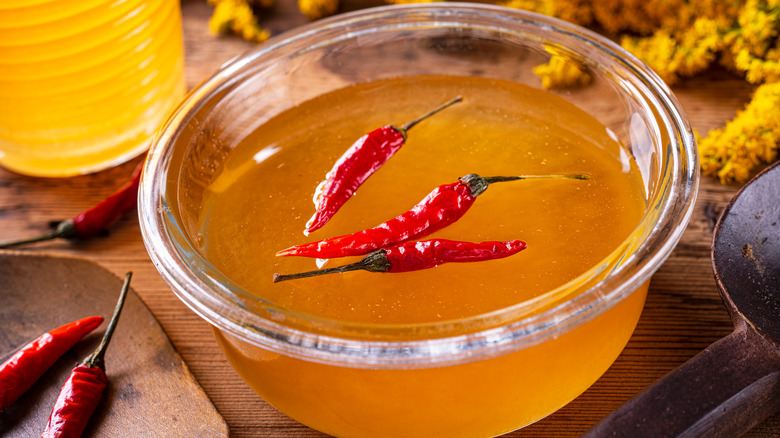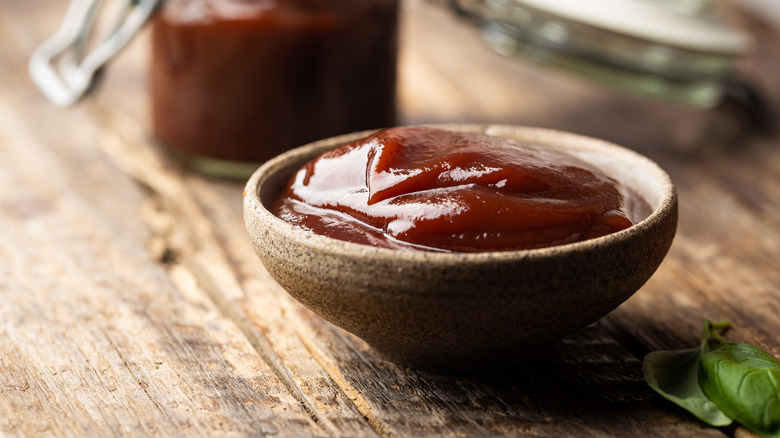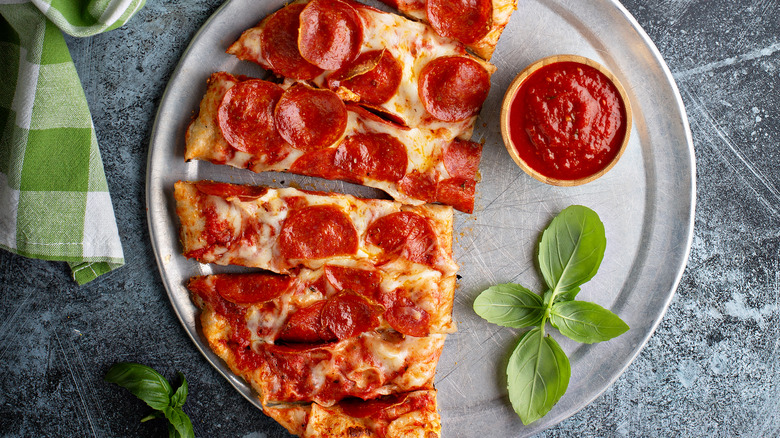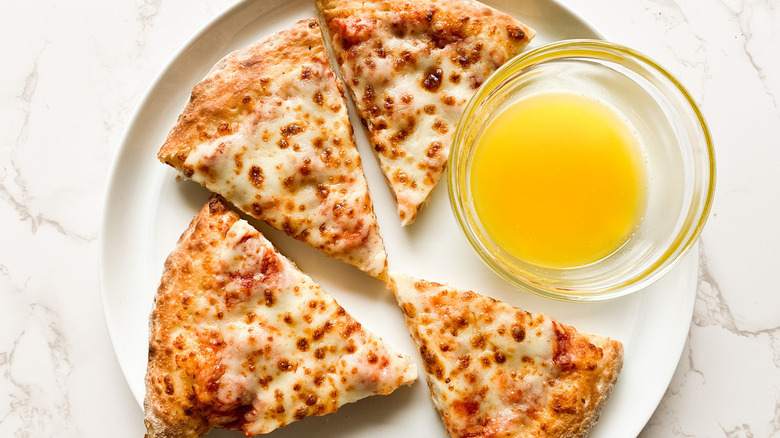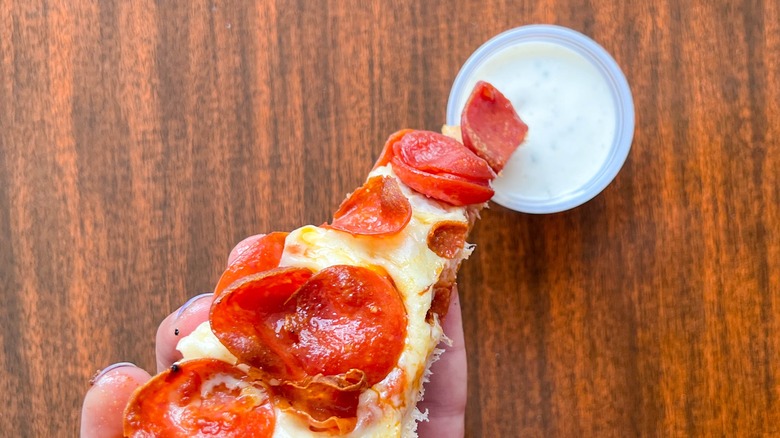The Ultimate Ranking Of Dipping Sauces For Your Pizza
We dip fries, wings, and breadsticks, so why not pizza? According to Eater, dipping sauces were first offered as an accompaniment to breadsticks by major chains Pizza Hut and Little Caesars, but Papa John's pioneered the pizza and dip combination in 1984. The chain's garlicky, buttery dipping sauce came alongside every pizza and proved to be a success, prompting other major pizzerias to follow suit. Now, you'll find a rainbow of creamy, zesty, spicy, cheesy, and even sweet dipping sauces offered by more and more pizza chains to please all dipping enthusiasts, whether you're dunking your crusts or the whole slice.
Not everyone is on board with this pizza dipping habit, however, commonplace it may be. Several pizza chefs expressed their distaste for the practice to the Independent, agreeing that if a pizza needs to be dipped, it's not authentic or well-made. And if you find yourself in Italy, the birthplace of pizza, you should never request a dipping sauce, according to Authentic Vacations.
Those of us who enjoy a good pizza dipping experience, however, can rejoice in the feast of options available. People are dipping their slices and crusts in all manner of sauces and condiments, from store-bought to handcrafted, and we've ranked the most popular ones here from iffiest to most delectable. So grab that pizza, whether it's delivered or homemade, and get dipping.
14. Ketchup
It may come as a shock to many people, as it did to Pizza Hut according to this tweet, but ketchup and pizza is a thing. Eating pizza with ketchup is common practice in many parts of the world, as this Reddit thread demonstrates. But it's also a contentious habit; one Redditor got widely roasted for expressing their love of the ketchup-pizza combo (to be fair, they did post on the subreddit titled "unpopular opinion," and that proved to be an accurate assessment based on the majority of responses).
Many Reddit users question the need for ketchup with pizza, as most pizzas already have tomato sauce as an element. Others claim that doubling up on similar products should negate any criticism since it's just adding a different tomato sauce to an item that already features it. While one detractor calls it an "abomination," fans of the combo, including Los Angeles-area caterers Basil Pizza Bar, seem to agree that it's the interplay of melty cheese and ketchup tanginess that makes the pairing work.
13. Mustard
Mustard is a perfect match for hot dogs, burgers, and deli sandwiches. But what about pizza? It's not unheard of, whether as a replacement for tomato sauce, a dip on the side, or drizzled over the top. As pizzeria owner Francis Garcia told Food Insider, mustard pizza was born in Trenton, New Jersey, out of a misunderstanding when an inebriated customer attempted to order a mushroom pizza. The misinterpreted request resulted in a pie topped with the tangy, yellow sauce, and now mustard pizza has gone viral, according to Today, for better or for worse.
As with ketchup, using mustard as a pizza dipping sauce is a divisive act, according to this r/unpopularopinion subreddit thread, with one commenter comparing it to "hate crimes against Italians," among other colorful remarks. But there's a fan base out there for honey mustard, specifically, as a pizza dip, as this thread shows. Homemade Pizza School agrees, praising its combination of mustard's tang and honey's sweet taste. They recommend using it as a dip for pies with mellower flavors, like white pizzas.
12. Balsamic dip
Balsamic vinegar is a common dip for bread and breadsticks at Italian restaurants, so it's not much of a stretch to imagine using the concentrated, tangy substance as a dipping sauce for pizza. Not all balsamic vinegar is created equal, though. Two types — Traditional Balsamic Vinegar and Balsamic Vinegar of Modena — are protected products and must adhere to strict production rules and exhibit particular characteristics in order to earn their official seal (per Eataly). You probably don't want to use these esteemed vinegars as a dip for your Domino's or DiGiorno, as they'll set you back a pretty penny.
Less expensive versions of balsamic vinegar grace the shelves of most grocery stores, and while they may not be able to compete with their elite brethren, they can make a tasty and cost-appropriate dip for your pizza slices and crusts. Homemade Pizza School recommends cooking balsamic vinegar down into a thicker glaze for dipping. Over on YouTube's Good Mythical Morning, balsamic glaze was pitted against cheese sauce in a head-to-head pizza dip battle. And while it lost the fan survey, the hosts surprised themselves by preferring it.
11. Chili oil
For those looking to spice things up, there are plenty of dipping options that'll add some heat to your pizza. Chili oil may not be the first thing pizza lovers think of as a dip, but infused oils are commonly used for dipping bread, so enjoying them with a pizza crust seems like a no-brainer. Classic pizzerias usually have a shaker of red pepper flakes on the table, so why not throw that heat into some oil and start dipping?
Chili oil comes in as many different varieties as there are cuisines and chili peppers, and they can all enhance the flavor and heat of your pizza in unique ways. New York pizzeria Paulie Gee's created a pie with Xi'an Famous Foods' Chili Oil & Crisps as a featured ingredient, which garnered a lot of love on Instagram. Gourmet food hub Williams Sonoma offers a few different spicy oils made for pizza, one with peppers from New Mexico and South America, and a more Italian-style, spicy and garlicky oil crafted in collaboration with pizza oven maker Ooni. There's sure to be a chili oil out there for anyone's heat tolerance and chili flavor preference, whether you're drizzling or dipping.
10. Pesto
The famed Margherita pizza, purportedly invented in Naples in 1889, boasts only three ingredients besides the crust: tomato, basil, and mozzarella cheese. There must be something special about the interplay of those flavors, considering this recipe has remained at the forefront of pizza-making for over a century. It makes sense that pesto would be a successful option as a dipping sauce for pizza — basil is the primary ingredient in traditional pesto, after all, so when it's combined with typical pizza toppings like cheese and tomato sauce, the spirit of Pizza Margherita is summoned.
St. Louis-based Dogtown Pizza recommends pesto as a dipping sauce for traditional styles of pizza since it interacts so well with flavors like tomato and garlic. Pesto can be used as a base sauce for pizza too, as a replacement for typical tomato sauce, but using it as a dip lets you have the best of both worlds. There are a variety of pestos that can be fun to pair with different pizzas, like this recipe that swaps out basil for cilantro.
9. Mayonnaise/Aioli
The terms mayonnaise and aioli are often used interchangeably on menus, though historically they are not the same. Traditional aioli consists of only garlic and oil, while mayonnaise is an emulsion involving egg yolk and doesn't always involve garlic. Despite their differences, both mayo and aioli offer creamy dipping goodness to all kinds of food, including pizza. While many people think of this pairing as controversial, as the heated comments on this Reddit thread show, it's not as uncommon as you might think around the world.
In Japan, mayo is often used as a pizza topping, squeezed onto a cooked pie in geometric patterns, per HuffPost. And in what may come as a shock to many pizza traditionalists, there's even a pizza in Italy that includes mayonnaise as one of its main ingredients. According to La Cucina Italia, Pizza Rossini is a local specialty from the town of Pesaro in the Marche — it's a classic Margherita pizza with the addition of sliced, hard-boiled eggs and drizzles of mayonnaise on top. If even the Italians, the most rigid of pizza rule adherents, can eat pizza with mayonnaise, then using the condiment as a dipping sauce for pizza might not be such a controversial thing after all.
8. Nacho cheese
Pizza already features cheese as one of its main ingredients, so dipping pizza in cheese sauce may seem like overkill. But if you love cheese — and as a pizza eater, you probably do — is there really too much of a good thing? In fact, in a sea of contentious pizza dipping sauce opinions, a Reddit user who posted a photo of themselves dipping pizza in nacho cheese was not met with a single negative comment. Could nacho cheese be the pizza dip that everyone agrees on?
Good Mythical Morning's fans chose nacho sauce overwhelmingly over its head-to-head competitor, balsamic glaze, with 80% of the votes. While it's not found at pizzerias as frequently as some of our more highly-ranked dipping sauces, you can get a side of cheese sauce to complement your pizza at Papa John's. Little Caesar's has cheddar cheese sauce occasionally, specifically made to go with their limited-time pretzel crust, and they also more widely offer a Cheezy Jalapeno sauce for a real nacho cheese kick. And lest you think cheese pizza and cheese sauce is going overboard, just know that there's a pizza out there with a crust made of cheese, too.
7. Blue cheese
Blue cheese may be one of those love-it-or-hate-it foods, but it's solidified its place in the pantheon of elite dips and dressings. It's practically impossible to imagine a plate of hot wings without a side of creamy, pungent blue cheese dressing, or an iceberg wedge salad not drenched in the stuff. And if you also enjoy it as a pizza dip, you're not alone. You'll find blue cheese dipping sauce at pretty much every major pizza chain, and it's not just for wings and salads. Domino's recommends it with pizza, particularly chicken pizzas.
As per usual, using blue cheese sauce as a pizza dip is a divisive topic on Reddit, but the combination does have its fans. One user says it's "10,000 times better than ranch," a position also vociferously echoed by many denizens of Buffalo, New York, who post on the r/Buffalo subreddit. Perhaps unsurprisingly, those who call the birthplace of Buffalo wings home consider blue cheese to be the ultimate dipping sauce, whether it's for slices of pizza or spicy chicken.
6. Hot sauce
There isn't enough time or space to go into detail about the vast array of hot sauces in the world, crafted from the countless chili peppers that grace our globe, ranging from pleasantly piquant to mouth-searingly nuclear. With the near-infinite variety of styles to choose from, the possibilities for pairing hot sauce with pizza are endless, whether you're looking for a dipping sauce that's a full five-alarm fire or one that just adds a subtle touch of heat.
The Washington Post breaks down the major hot sauce styles, including the increasingly popular Sriracha. This garlicky, somewhat sweet chili sauce makes a great spicy dip for pizza, either on its own for the full effect or mixed with mayo to mellow its heat, as Homemade Pizza School suggests. Pizza fans on the subreddit r/hotsauce go for any hot sauce that includes garlic, which makes sense with the bulb's affinity with most pizza flavors. You'll find buffalo sauce options at many major pizza chains, like Domino's, which offers it as a side dip or drizzled on top if you're feeling confident.
There are so many others, too. Like a more mellow kick? Try a green sauce. More of a vinegar tang? Go for a Cajun style, like Crystal. Or go wild with adjika, a spicy chili sauce from the country of Georgia, tailor-made for dipping.
5. Hot honey
If you're a fan of the combination of sweet and spicy, the best pizza dipping sauce for you might just be hot honey. You may have come across Mike's Hot Honey in pizzerias across the U.S., which has become something of a sensation among pizza enthusiasts. Creator Mike Kurtz was inspired by his time living in Brazil, where he noticed chili-infused honey on pizzeria tables and fell hard for the flavor. He brought the concept back with him when he returned home to the U.S. and found an enthusiastic audience for his chili-infused honey that hasn't stopped growing.
The sweetness of honey mellows the tang and heat of more intense pizza ingredients, and the piquancy of the infused chilis adds a layer of fiery flavor to milder slices. The balance of both sides of the coin might explain why hot honey makes such a fantastic accompaniment to pizza of all kinds and pleases so many palates.
4. Barbecue sauce
Just as with hot sauce, it's tough to shove all types of barbecue sauce into one category. But the most common version that's served as a dipping sauce with pizza tends to be the sweet and tangy, viscous, and savory tomato-based sauce most similar to Kansas City or St. Louis style, per Today. Papa John's version is primarily tomato puree, vinegar, and molasses, while Pizza Hut and Domino's both sweeten their BBQ sauces with honey. Other regional styles of barbecue sauce might not be as popular with pizza, but there's no reason not to try them all.
Pairing BBQ sauce with a meat-laden pizza makes all kinds of sense, considering that meat is what the sauce was made for. The now commonplace barbecue chicken pizza is a relatively recent invention, credited to Chef Ed LaDou who helped launch California Pizza Kitchen in the '80s, according to the Los Angeles Times. But barbecue sauce isn't just for poultry, so using it as a dipping sauce for pizza with other meat toppings is a great idea too. If your pizza joint's barbecue sauce isn't zesting up your slice enough, don't be afraid to perk it up as Bobby Flay does.
3. Marinara sauce
If tomatoes are your favorite element of pizza, a side of marinara sauce for dipping is probably the top choice for you. You could say marinara is the torchbearer of pizza dipping sauces since Pizza Hut has been serving it on the side since 1958, as noted by Eater. It was originally intended for breadsticks, but it's just as good for dunking crusts or the whole slice for dippers who want to boost their tomato sauce experience. You'll find marinara at pretty much any pizzeria, from major chains to mom-and-pop restaurants.
While it may seem like marinara and pizza sauce are identical, in most cases, the two are subtly but critically distinct. MasterClass points out the main differences, chief among them texture — pizza sauce needs to be loose so that it can be spread over the crust, while marinara is thicker, which makes it perfect as a dip. Marinara is all about bright tomato flavor, simply enhanced by olive oil, garlic, red pepper, and Italian herbs like basil or oregano, as The New York Times explains. So, tomato sauce aficionados need not apologize for doubling down — pizza sauce and marinara bring their own unique qualities to the table.
2. Garlic sauce
Garlic and pizza are historically intertwined — in fact, some of the earliest iterations of what we now know as pizza featured garlic as their main topping, along with other items like lard, cheese, and salt, according to History Today. Fast forward a few hundred years to the creation of pizza chain Papa John's garlic dipping sauce, which diners can use to imbue each bite of their slice with unctuous, garlicky, salty goodness. Perhaps peoples' taste buds haven't changed much over the centuries, after all. Papa John's iconic sauce delivers in all of those categories. Interestingly, while often described as garlic butter, the recipe includes no dairy whatsoever and is in fact vegan friendly, as Papa John's tweeted.
Countless Papa John's garlic sauce copycat recipes, and since its inception, other major pizza chains have created their own garlic dipping sauces. Pizza Hut features parmesan in their version, while Domino's went for a garlic-forward flavor, which has garnered mixed reactions from Domino's fans on Reddit. Since garlic and pizza are a match made in heaven, no need to confine yourself to one style of garlic dip, either. Even Papa John's ventured from its classic recipe and featured a spiced-up option in 2020.
1. Ranch
You can delve into the history and science all you want, or get caught up in the endless controversy that rages in places like Reddit, but the fact remains that ranch dip and pizza are a power couple. No other dipping sauce elicits as much online discourse when it comes to pizza, and whether you love it or hate it, ranch seems to be here to stay. The creamy, herbal concoction is available at just about every pizzeria, even if you have to pay a king's ransom for the privilege. According to Eater, in 2014, one Dallas pizza restaurant somewhat jokingly charged $1,000 for a side of the sauce and banned any ranch smuggled into their establishment.
As with most of these dipping sauces, there's no hard-and-fast recipe when it comes to ranch. Most people are familiar with Hidden Valley, which is a mainstay on grocery store shelves. The dressing is made with buttermilk, garlic, onion, MSG, and other seasonings, which create the special ranch-ness that has catapulted it to stardom. Other ingredients often include alliums and herbs, like chives, parsley, and dill, and a base of mayonnaise and/or sour cream in addition to buttermilk to create the creamy, tangy texture. We may never understand exactly why it works, but the cooling, herby dressing mixed with a cheesy, greasy, crusty slice of pizza somehow creates undeniable alchemy.
